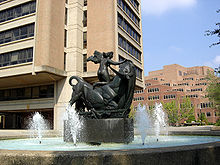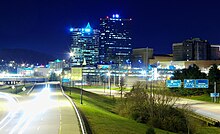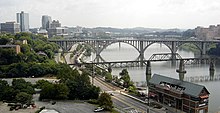Knoxville, Tennessee
[19] The city was bitterly divided over the issue of secession during the American Civil War and was occupied alternately by Confederate and Union armies, culminating in the Battle of Fort Sanders in 1863.[30] The first major recorded Euro-American presence in the Knoxville area was the Timberlake Expedition, which passed through the confluence of the Holston and French Broad into the Tennessee River in December 1761.Henry Timberlake, an Anglo-American emissary from the Thirteen Colonies to the Overhill settlements, recalled being pleased by the deep waters of the Tennessee after his party had struggled down the relatively shallow Holston for several weeks.[31] The end of the French and Indian War and confusion brought about by the American Revolution led to a drastic increase in Euro-American settlement west of the Appalachian Mountains.In 1790, President George Washington appointed North Carolina surveyor William Blount governor of the newly created Territory South of the River Ohio.Its location at the confluence of three major rivers in the Tennessee Valley brought flatboat and later steamboat traffic to its waterfront in the first half of the 19th century, and Knoxville quickly developed into a regional merchandising center.[40] Blount County, just south of Knoxville, had developed into a center of abolitionist activity, due in part to its relatively large Quaker faction and the anti-slavery president of Maryville College, Isaac Anderson.[42] Business interests, however, guided largely by Knoxville's trade connections with cotton-growing centers to the south, contributed to the development of a strong pro-secession movement within the city.[46] As Burnside was fortifying Knoxville, a Confederate army under Braxton Bragg defeated Union forces under William Rosecrans at the Battle of Chickamauga (near the Tennessee-Georgia line) and laid siege to Chattanooga.[53] In 1869, Thomas Humes, a Union sympathizer and president of East Tennessee University, secured federal post-war damage reimbursement and state-designated Morrill Act funding to expand the college, which had been occupied by both armies during the war.[19] In 1901, train robber Kid Curry (whose real name was Harvey Logan), a member of Butch Cassidy's Wild Bunch was captured after shooting two deputies on Knoxville's Central Avenue.While government jobs and economic diversification prevented widespread unemployment in Knoxville, the city sought to recover the massive loss of revenue by attempting to annex neighboring communities.[59] Knoxville officials attempted the annexation of the neighboring Farragut-Concord community in western Knox County, but the city failed following the incorporation of Farragut in 1980.Ashe's efforts were controversial, largely consisting of annexation of interstate right-of-ways, highway-oriented commercial clusters, and residential subdivisions to increase tax revenue for the city.[67] The development consisted of three office buildings, including a headquarters for Regal Entertainment Group, a hotel, student housing, and 300 multi-family residential units.[69] In August 2020, UT President and Tennessee Smokies owner Randy Boyd announced plans of a mixed-use baseball stadium complex in the Old City neighborhood.Municipalities in the CSA but not the Knoxville MSA, include Morristown, Rutledge, Dandridge, Jefferson City, Sevierville, Gatlinburg, Pigeon Forge, LaFollette, Jacksboro, Harriman, Kingston, Rockwood, and Newport.[95][97] According to the opinion of the Economic Research Institute in a 2006 study, Knoxville was identified as the most affordable U.S. city for new college graduates, based on the ratio of typical salary to cost of living.Major brokerage firms with offices in Knoxville include Edward Jones, Morgan Stanley Smith Barney, Wells Fargo, and Merrill Lynch.[117] The city is home to several automobile parts operations, including ARC Automotive (air bag actuators) and a Key Safety Systems plant (seat belts and other restraints).[141] The downtown area contains a mixture of architectural styles from various periods, ranging from the hewn-log James White House (1786) to the modern Knoxville Museum of Art (1990)."Streetcar suburbs" such as Fourth and Gill, Parkridge, and Fort Sanders, developed in the late 19th century with the advent of trolleys, tend to contain large concentrations of Victorian and bungalow/Craftsman-style houses popular during this period.[142] Other notable local architects include members of the Baumann family, Charles I. Barber (son of George), R. F. Graf, and more recently, Bruce McCarty.Interim mayor Daniel Brown, the first African American to hold the office, was appointed in January 2011 following the resignation of Bill Haslam, who was elected Governor of Tennessee.[201] Jewelry Television, a home shopping channel, is also based in the city, and several companies that provide production services to the ex-SNI networks also maintain Knoxville operations.[218] State Route 158 (SR 158) loops around the Downtown area from Kingston Pike just west of UT's campus, southward and eastward along Neyland Drive and the riverfront, and northward along the James White Parkway before terminating at I-40.[226] CSX controls about 76 miles (122 km) of tracks in the Knoxville area, much of which is located along an important north–south line between Cincinnati and Louisville to the north and Chattanooga and Atlanta to the south.[231] Most commercial shipping on the Tennessee River is provided by barges, which deliver on average half a million tons of cargo to Knoxville per year, mostly asphalt, road salt, and steel and coke.[234] Mark Twain wrote about a gunfight in downtown Knoxville involving Joseph Mabry Jr., owner of the city's antebellum Mabry-Hazen House in Life on the Mississippi from 1883.[237] Pulitzer Prize-winning author Peter Taylor's last novel in 1994, In the Tennessee Country, refers to a "Knoxville cemetery" where the main character's grandfather (a fictitious politician) is buried.
























Knoxville (disambiguation)Downtown KnoxvilleMarket SquareNeyland StadiumSunsphereWorld's Fair ParkGay StreetOld Gray CemeteryAyres HallUT KnoxvilleTennessee AmphitheaterTennesseeCountyJames WhiteNamed forHenry KnoxMayor–councilIndya KincannonDemonymTime zoneUTC−5UTC−4Zip codeArea codecounty seatKnox County, TennesseeTennessee River2020 United States censusEast TennesseeGrand Divisionthird-most-populous cityNashvilleMemphisKnoxville metropolitan areaAmerican Civil WarConfederateBattle of Fort Sandersmanufacturing sector collapseddowntown area declined1982 World's Fairrevitalization initiativesUniversity of TennesseeTennessee VolunteersTennessee Valley AuthorityTennessee Supreme CourtAppalachianGreat Smoky Mountains National ParkHistory of Knoxville, TennesseeTimeline of Knoxville, TennesseeWoodland periodburial moundMississippian cultureBlountDallas phaseBussell IslandLittle Tennessee RiverLenoir CityCherokeeIroquoian languageGreat Lakes regionShawneeOverhill settlementsTennessee ValleyHernando de SotoTimberlake ExpeditionHolstonFrench BroadHenry TimberlakeThirteen ColoniesJames White's FortFrench and Indian WarAmerican RevolutionAppalachian MountainsRevolutionary WarWhite's FortCharles McClungGeorge WashingtonWilliam BlountTerritory South of the River OhioTreaty of HolstonClinch RiverKingstonHanging MawCraighead-Jackson HouseMurfreesboroKnoxville GazetteflatboatsteamboatDeep SouthEast Tennessee and Georgia RailroadHugh Lawson WhiteAndrew JacksonWhig PartyKnoxville CampaignWilliam "Parson" BrownlowKnoxville WhigQuakerMaryville CollegeGreater Warner Tabernacle AME Zion ChurchUnderground RailroadJ. G. M. RamseyRamsey HouseEast Tennessee ConventionGreenevilleConfederacyFelix Zollicoffermartial lawburned seven of the city's bridgesGeorge CrittendenKirby Smithunsuccessful invasion of KentuckySimon Bucknercolonial fortAmbrose BurnsideLoudonBraxton BraggWilliam RosecransBattle of ChickamaugaChattanoogaJames LongstreetJoseph WheelerBattle of Campbell's StationFarragutWilliam P. Sanderstwo-week siegeattacked Fort Sanders
